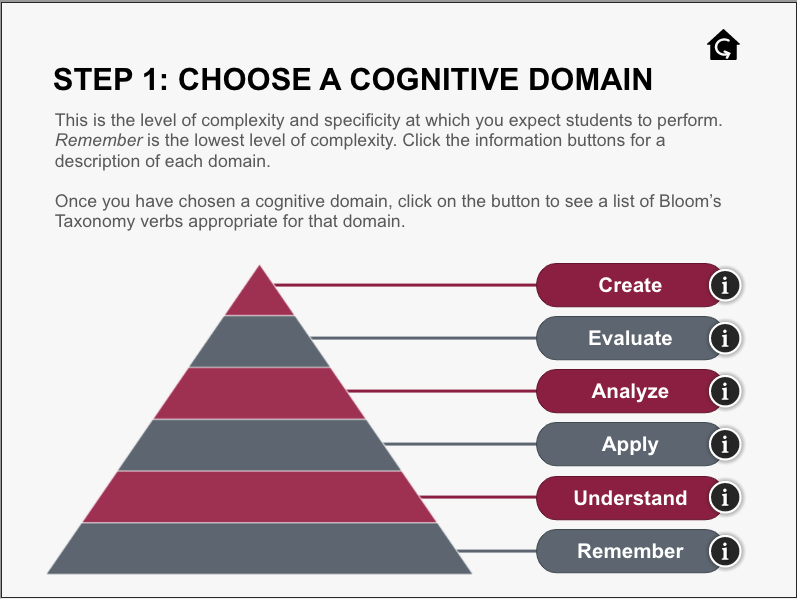Option 2: Crafting Course Outcomes
 A great deal has been written about what a learning outcome (Bloom, 1956; Allan, 1996; Hussey & Smith, 2002) is as well as the difference between a learning outcome and a course objective. Unfortunately there is not a great deal of consistency with the use of language when it comes to outcomes vs objectives or even goals. For the purpose of this resource (and the work that we do at the Teaching Centre) we are going to use the following definitions to describe the terms goals, objectives and learning outcomes (as identified by the Undergraduate Education and Academic Planning group at San Francisco State University):
A great deal has been written about what a learning outcome (Bloom, 1956; Allan, 1996; Hussey & Smith, 2002) is as well as the difference between a learning outcome and a course objective. Unfortunately there is not a great deal of consistency with the use of language when it comes to outcomes vs objectives or even goals. For the purpose of this resource (and the work that we do at the Teaching Centre) we are going to use the following definitions to describe the terms goals, objectives and learning outcomes (as identified by the Undergraduate Education and Academic Planning group at San Francisco State University):
This option gives you the opportunity to craft your own course outcomes. In this option you will do the following:
- Define goals, objectives, and outcomes
- Review Bloom’s Learning Taxonomy
- Review the revised Bloom’s Taxonomy
- Gain practice writing learning outcomes
Goal – A goal is a broad definition of student competence. Examples of these goals include:
- Students will be competent in critical questioning and analysis.
- Students will have an appreciation of the necessity and difficulty of making ethnical choices.
- Students will know how to make connections among apparently disparate forms of knowledge.
Objective – A course objective describes what a faculty member will cover in a course. They are generally less broad that goals and broader than student learning outcomes. Examples of objectives include:
- Students will gain an understanding of the historical origins of art history.
- Student will read and analyze seminal works in 20th Century American literature.
- Students will study the major U.S. regulatory agencies.
A few of the key points:

- Course objectives are often a description of what the Faculty member/instructor will cover in the course
- Learning outcomes are student focused and written in such a way that they are measurable/observable
- Identify the most frequently encountered endings for nouns, adjectives and verbs, as well as some of the more complicated points of grammar, such as aspect of the verb
- Read basic material relating to current affairs using appropriate reference works, where necessary.
- Make themselves understood in basic everyday communicative situations.
*retrieved from https://ueap.sfsu.edu/sites/default/files/assets/docs/student_learning_outcomes.pdf April 3rd, 2020.
To write learning outcomes, we need to understand not only what we want our students to be able to demonstrate upon completion, but at which level we expect them to be able to complete it. Accordingly, we need a common language to identify possible levels of understanding. There are several educational taxonomies that will help us to find the language necessary to write these outcomes.
Bloom’s Taxonomy (revised) – In 2000, authors Lorin Anderson and David Krathwohl published a book titled A taxonomy for learning, teaching, and assessing: a revision of Bloom’s taxonomy of educational objectives. In this book they make a case for updating the original work of Benjamin Bloom. This revised version updates some of the terminology that was originally used AND changes the order of the top two levels. This video will help to explain the revised taxonomy as well as providing some examples on how these would be applicable to online learning activities (9 minutes 5 seconds):
Here is a graphic that illustrates both the original Bloom’s Taxonomy and the revised version of 2000:

There are other several other taxonomies that might be of interest when thinking about how learning objectives can be written/framed. Some of the other prominent taxonomies are:
- The Six Facets of Understanding by Wiggins and McTighe (1998) – discussed in detail in their Understanding by Design book. Here is a link to a whitepaper published by the ASCD.
- The SOLO (Structure of Observed Learning Outcomes) taxonomy by Biggs and Collis (1982) – outlined in their book Evaluating the quality of learning: the SOLO taxonomy (structure of the observed learning outcome). Here is a link to an overview of the SOLO taxonomy created by Future Learn.
- The Taxonomy of Significant Learning by Fink (2003) – published in his book Creating Significant Learning Experiences. Here is a link to an overview of the Taxonomy of Significant Learning put together by the Peak Performance Centre.
The process of writing learning outcomes then becomes a matter of matching the level of skill/understanding that you expect your students to demonstrate with specific area of understanding and how you will expect them to be able to demonstrate this to you (and themselves). There are many resources that can be extremely helpful in writing outcomes, but probably one of the easiest to use (and most visual) is this one by Arizona State University.

By following the steps in their outcome (they use the term objective) builder, you can quickly write learner-centred outcomes for your class.
Additional Resources:
The following additional resources may be of interest but are not required:
- Constructing a Course Outline or Syllabus (Teaching Centre, University of Lethbridge)
- Foundations of a Course Outline Template (Ryerson University)
- List of Measurable Verbs used to Assess Learning Outcomes (Clinton Community College)
- Blooms Taxonomy of Measurable Verbs (PDF) (Utica College)
If you would like feedback from peers and/or facilitators on any aspect of your syllabus or course outcomes, please feel free to share it in the Module Discussion Forum.
References:
Allan, J., (2006). Learning outcomes in higher education, Studies in Higher Education, Vol. 21, Issue 1, pp 93-108.
Bloom, B., ed. (1956). Taxonomy of Educational Objectives. Handbook 1 cognitive domain, London: Longman
Biggs, J. B., & Collis, K. F. (1982). Evaluating the quality of learning: The SOLO taxonomy (structure of the observed learning outcome). New York: Academic Press.
Fink, L. D. (2003). Creating significant learning experiences: An integrated approach to designing college courses (1st ed.). San Francisco, Calif: Jossey-Bass.
Hussey, T., Smith, P. (2002). The Trouble with Learning Outcomes, Active Learning in Higher Education, 3(3), 220-233.
Wiggins, G. P., McTighe, J., & NetLibrary, I. (2005). Understanding by design (Expand 2nd ed.). Alexandria, VA: Association for Supervision and Curriculum Development.
Media Attributions
- structure is licensed under a CC0 (Creative Commons Zero) license
- learning_objective_builder

